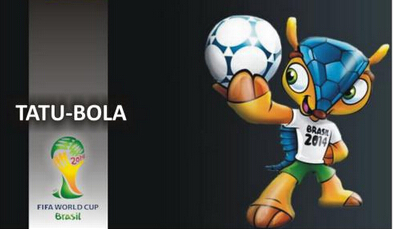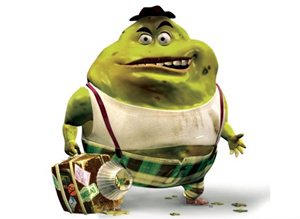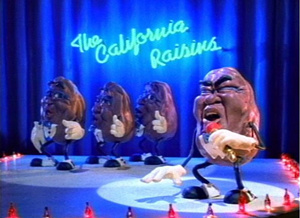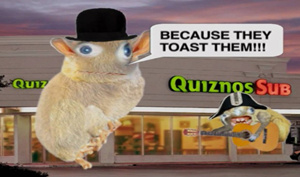玩偶的悲伤 十大能把人吓哭的吉祥物
日期:2014-06-16 11:43
(单词翻译:单击)

麦当劳(McDonald)的新版吉祥物Happy一直被戏称为“太吓人”,至少在一些观察家看来的确如此:拟人的大牙齿;疯狂凸出的大眼睛;还有纤细得有些怪异的胳膊。而这个吉祥物的另一面也令人担忧:这很明显是焦点小组驱动的公司官僚机构为了满足内部支持者们的产物,而不是来自一支创意团队的原创作品。

吉祥物Happy明显受到海绵宝宝的启发,不难想象,它肯定经过了一遍又一遍地测试,接受了一系列顾问的严格审查,并且不断调整,直到没有人感到被冒犯。但这只是在它未公开亮相之前。Happy公布以后,几乎所有人都感觉不舒服。但令人恐惧的Happy并不不是一个人人。让我们来看看还有哪些令消费者不寒而栗的吉祥物吧。

快乐的绿巨人
The Jolly Green Giant was such a popular character that the company he represented, the Minnesota Valley Canning Co., took his name in 1950. But in his earliest iterations in the '20s and '30s, the Green Giant didn't always seem so jolly. In fact, it was the future ad wizard Leo Burnett who in 1935 added the "Jolly" to the Green Giant's name and who took the first steps toward making him less terrifying in print ads, in part by replacing his scowl with a smile. In the character's first TV spots in the '50s, though, the giant was scarier than ever. Finally the by-then-thriving Burnett agency discovered that by downplaying the his presence, he was not only far less frightening, but also far more effective.
快乐的绿巨人深受人们喜爱,因此明尼苏达山谷罐头公司(Minnesota Valley Canning Co.)1950年注册了这个名字,用他作为代言人。但在上世纪20年代至30年代,早期的几代绿巨人形象似乎并不快乐。事实上,直到1935年,未来的广告奇才李奥•贝纳才在“绿巨人”的名字前面加上了“快乐的”三个字,并开始采取措施改变印刷广告上绿巨人令人恐惧的形象,主要做法是用笑容取代了绿巨人的怒容。但在50年代,这个角色第一次在电视上出现时,他的形象反而更加恐怖。最终,当时蒸蒸日上的贝纳广告公司(Burnett)发现,通过简化绿巨人的形象,不仅使它不再那么令人恐惧,而且效果更佳。

鼻涕先生
We all complain about TMI ads that spend 30 seconds focused on some distasteful body function or embarrassing malady. But hey, products for gross stuff deserve marketing too. Enter Mr. Mucus, which can most accurately be described as an anthropomorphized glob of snot. He is the villain in a series of spots for Mucinex, the expectorant originally marketed by Adams Respiratory Therapeutics. But Mr. Mucus might soon meet his demise: Reckitt Benckiser, which acquired Adams in 2007, is reviewing its advertising and might end the phlegmy foe's 10-year run.
有些广告会用30分钟描述一些令人不快的身体机能或令人尴尬的疾病。我们往往会抱怨这种信息量过多的广告。但别忘了,针对令人恶心之物的产品也应该有开展市场营销的机会。让我们看看“粘液先生”吧。准确地说,粘液先生是一滴拟人化的鼻涕。在祛痰药物Mucinex的一系列广告中,粘液先生一直扮演大反派。这款药物最初由亚当斯呼吸道药品公司(Adams Respiratory Therapeutics)销售。不过,粘液先生的使命或许即将结束:亚当斯呼吸道药品公司于2007年被利洁时集团(Reckitt Benckiser)收购。后者目前正在评估亚当斯呼吸道药品公司的广告,或许将终止这款祛痰药长达10年的系列广告。

文洛克与曼德维尔
The pre-jolly Green Giant proved that original, creative ideas aren't always good. But as McDonald's "Happy" shows, soulless, systematized, bureaucratic approaches to mascot development (and most other kinds of development) almost never produce anything worthwhile. It reportedly took 18 months and 40 focus groups to come up with Wenlock and Mandeville, the cycloptic creatures that represented the 2012 Olympics in London. One critic decided the pair was the result of a "drunken one-night stand between a Teletubby and a Dalek."
之前的“快乐的绿巨人”证明,原创的、有创意的设计不一定总是好的。但麦当劳的新吉祥物“Happy”却表明,在吉祥物创作(和几乎其他大多数类型的研发)过程中,缺少灵魂的、系统性的、官僚主义的方式基本不可能诞生出有价值的作品。据报道,有40个焦点小组历时18个月才想出文洛克和曼德维尔——代表2012年伦敦奥运会的两个独眼生物。一位批评家表示,这两个生物是天线宝宝(Teletubby)和戴立克(Dalek)酒后一夜情的产物。

6号先生
Imagine Uncle Junior from The Sopranos dancing wildly while in the deepest throes of a month-long meth tweak, and you have Mr. Six. The mascot for the Six Flags theme parks was introduced to the public for some reason in 2004. Although creatively speaking not much above a rappin' grandma, Mr. Six proved to be effective, especially among kids, and has been widely parodied. Nevertheless, when Washington Redskins owner Daniel Snyder purchased Six Flags in 2005, he announced the very next day that Mr. Six would be deep-sixed. He was brought back in 2005, prompting Time magazine to wonder: "Why Is Six Flags Targeting Kids with a Creepy Old Guy?"
大家可以想象一下《黑道家族》(The Sopranos)中的尤尼奥尔叔叔在戒毒一个月期间毒瘾发作最痛苦时疯狂跳舞的情景,这便是6号先生。六旗主题公园(Six Flags)2004年因为某些原因推出6号先生作为自己的吉祥物。虽然从创意来说无法超越“说唱祖母”,但事实证明,6号先生产生了很好的效果,尤其是受到了孩子们的欢迎,而且得到了许多人模仿。2005年,华盛顿红人队(Washington Redskins)老板丹尼尔•斯奈德收购六旗主题公园,交易第二天,他便宣布放弃使用6号先生。但在2005年,这座公园重新启用了这个吉祥物。《时代》(Time)杂志不由得发出疑问:“以儿童为目标群体的六旗主题公园为什么用一个古怪的老家伙作为吉祥物?”

加州葡萄干
Few brand mascots are as well known as the California Raisins, and that's only partly because the desiccated Claymation characters have served as the basis for a million jokes about the aging Rolling Stones. The Raisins characters owned TV advertising in the '80s -- they had their own line of merchandise and even an Emmy-winning mockumentary, Meet the Raisins! in 1988. But let's face it, those dried grapes look as likely to eat us as we are to eat them.
很少有品牌的吉祥物能像加州葡萄干一样出名,而其中很大一部分原因是,在与老迈的滚石乐队(Rolling Stones)有关的无数笑话中,这些干瘪的粘土动画人物都是不可或缺的笑料。上世纪80年代,这帮葡萄干人物拥有电视广告,有自己的产品,甚至1988年的伪纪录片《遇见葡萄干》(Meet the Raisins! )还曾经荣获艾美奖。但我们不得不承认,这些干瘪的葡萄看起来像是要吃掉我们,而不是被我们吃掉。

国王
Sometimes, being horrifyingly creepy is the whole idea. So it was with Burger King's "The King," which ran from 2003-2011. Meant to become a viral hit, The King succeeded -- and after people started referring to the character as "The Creepy King" (to differentiate it from its earlier, friendlier iterations), Burger King (BKW) was more than happy to accept the appellation.
有时候,让吉祥物吓人恰恰就是商家的目的。汉堡王(Burger King)的“国王”便是如此。汉堡王在2003年至2011年期间使用“国王”作为吉祥物,希望他能够获得病毒性传播。 “国王”果然不负众望——后来人们开始把他称作“恐怖国王”(为了与之前更友好的形象区分开来),而汉堡王似乎乐得接受这样的称呼。

柠檬头
In its by-the-numbers interview of the branding person responsible for the revamping of the eponymous character that represents Lemonhead candy, the Chicago Tribune somehow neglected to ask, "Why are you trying to give our children nightmares?" The movie-theater staple had been produced in Chicago by Ferrara Candy Co. for 52 years. The updated mascot looks a lot like the old one, except that the old one looks a lot less likely to be carrying a length of rope.
这个吉祥物代言的产品是柠檬头糖果。《芝加哥论坛报》(Chicago Tribune)曾对该公司负责修改吉祥物的品牌推广人员进行过常规采访。只是,他们似乎忘了问一个问题:“你们为什么想让我们的孩子做恶梦?”芝加哥费拉拉糖果公司(Ferrara Candy Co.)生产这款主打电影院市场的产品,已有52年历史。最新的吉祥物与“前辈”类似,只是它看起来失败的风险会更大。

奎兹诺斯连锁快餐店吉祥物
Like Burger King's "The King," the Spogmonkeys are meant to be disturbing and weird. The characters served for a time as the spokescreatures for the Quiznos sandwich chain, but were originally developed by a private citizen, Joel Veitch, and were already popular online. The campaign, while attention-getting, didn't last long, perhaps because somebody realized that advertising food by using floating, genetically mutated rodents wasn't a good idea.
与汉堡王的“国王”一样,Spogmonkeys的目的也是为了产生令人不安和古怪的效果。这些形象曾经作为奎兹诺斯(Quiznos)三明治连锁店的代言人,但它们最初确实出自普通人乔尔•维奇之手,并且早已在网上走红。广告虽然吸引了眼球,但并没有持续太长的时间,或许是因为有人意识到,用漂浮的、发生了基因突变的啮齿动物为食物做广告并不是什么好主意。

麦当劳叔叔原型
The Ronald McDonald we know today has had most of his personality shaved away by years of bureaucratic decision-making. But in his first iteration, played by future "Today Show" weatherman Willard Scott, he had too much personality, and might well have been the reason people started thinking of clowns as scary and creepy.
我们今天熟知的麦当劳叔叔的大多数个性早已被多年的官僚主义决策磨平。但最初由后来成为《今日秀》(Today Show)气象员维拉德•斯科特扮演的第一代麦当劳叔叔却非常有个性,或许人们认为小丑令人恐惧和古怪正是因为受到他的影响。

重点单词

